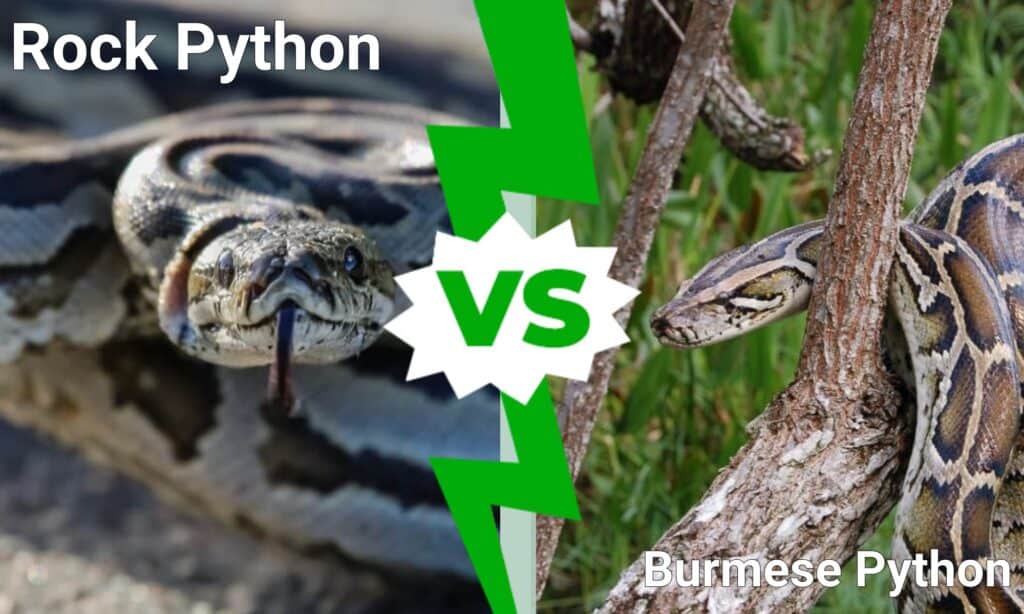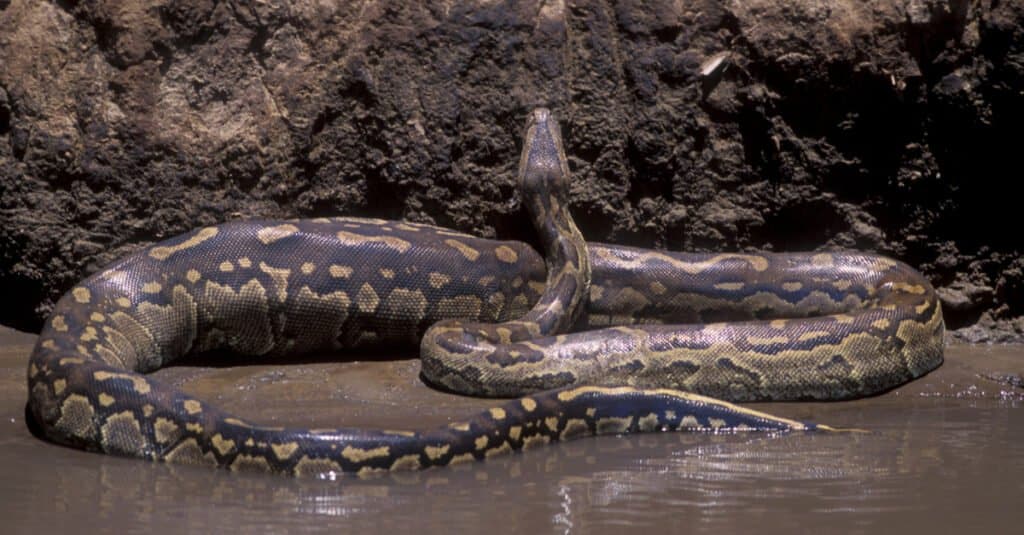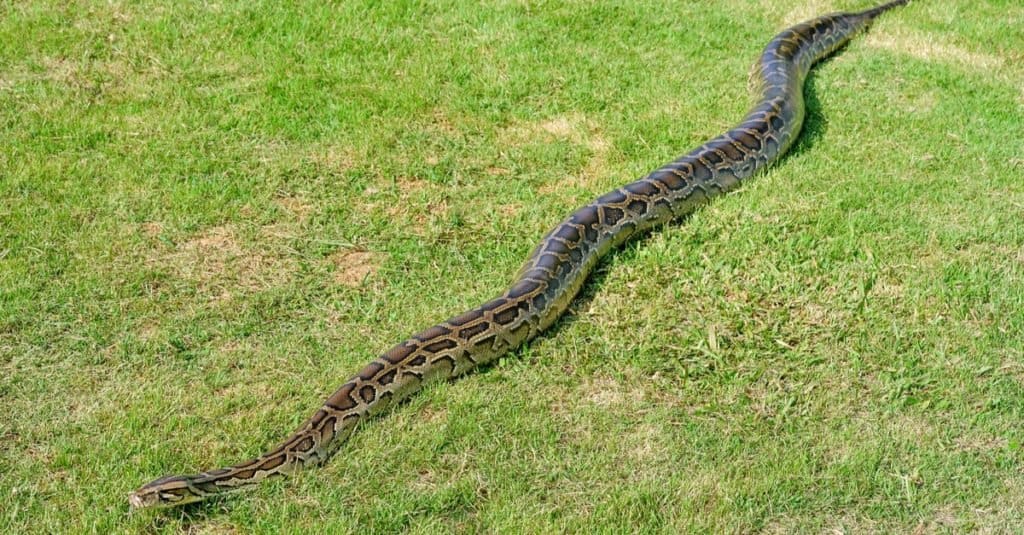Snakes come in all shapes and sizes. While it is easy to tell some of them apart based on size, colors, or the presence of a rattle or horns, it’s not always that simple. In this case, we have identified two snakes from the same genus that are very similar. Today, we’re going to compare the rock python vs Burmese python and show you the differences between these snakes.
Specifically, we’re going to compare the Central African rock python in this case as it is the largest creature referred to as a rock python. Get ready to learn how to tell these snakes apart! Fair warning, though, you may need to get up close and personal with these snakes to differentiate them!
Comparing a Rock Python and a Burmese Python

| Rock Python | Burmese Python | |
|---|---|---|
| Size | Weight: 71 to 121 lbs Length: 9 ft to 12 ft | Weight: 100 to 200 lbs Length: 10 to 18 ft |
| Color | – White, tan, or yellowish base – Patterns of dark tan, olive, gray-brown – Smaller blotches, or saddles, and more variety in their blotch shapes – V-shaped brown splotch on the head with a thin tan line – Have black spots throughout their light-colored ventral scales | – Tan base – Dark brown splotches along the sides and back – Blocky pattern of shapes that are described as giraffe-like puzzle pieces – Head has a V-shaped splotch in dark brown with a thick tan line down the center – Has light tan ventral scales |
| Diet | – Impalas, juvenile crocodiles, wild dogs, lions, cheetahs, monitor lizards, rodents, bats, goats, and more | – Rats, birds, foxes, alligators, raccoons, birds, dogs, goats, and more |
| Distribution | – Central and southern Africa – Senegal, Somalia, South Africa, Ethiopia – The Asian rock python lives in Southeast Asia and the Indian Subcontinent – Established as an invasive species in Florida, USA – Lives near permanent bodies of water – Forests, near rivers, semidesert, swamps, rainforests | – Southeast Asia – India, Cambodia, Vietnam, China, Nepal, and many other countries – Invasive species in Florida, USA – Prefers to live near permanent water fixtures – Near swamps, rivers, rainforests, marshes, and other areas |
The 4 Key Differences Between a Rock Python vs Burmese Python

Burmese pythons are some of the largest snakes in the world.
©Heiko Kiera/Shutterstock.com
The greatest differences between a rock python and a Burmese python are their size and distribution. The Burmese python is larger than the rock python, measuring between 10 and 18 feet on average and weighing between 100 and 200 pounds. Yet, the rock python weighs between 71 and 121 pounds on average and grows between 9 and 12 feet. The rock python is found in central and southern Africa, and it is an invasive species in the U.S. The Burmese python is found primarily in Southeast Asia as well as the Indian subcontinent.
These are two of the biggest differences between these snakes, but others exist, too. Let’s take a closer look at all four of the ways these snakes differ from one another.
Rock Python vs Burmese Python: Size
The average Burmese python is larger than the average rock python. The Burmese python weighs up to 200 pounds, and it measures up to 18 feet long. However, the rock python only weighs about 121 pounds and grows to be about 12 feet long.
However, specimens of both snakes have been discovered that greatly exceed the average measurements. The largest Burmese python measured 18 feet long and weighed 215 pounds. Yet, many other unsubstantiated and unconfirmed reports have shown that larger versions of these snakes may exist. Meanwhile, the largest rock python ever discovered measured 19 feet long and weighed 200 pounds.
Rock Python vs Burmese Python: Color

African rock pythons have a wider range of colors than Burmese pythons.
©zaferkizilkaya/Shutterstock.com
Rock pythons and Burmese pythons are very difficult to tell apart in color unless you have them right next to each other. For the most part, rock pythons have a white, tan, or yellowish base color on their bodies. Burmese pythons usually have a tan base that is often lighter in color.
Rock pythons have splotches, sometimes called saddles, on their bodies. These patterns come in a variety of shapes and sizes, but they are close together. The splotches can appear as dark tan, olive, or gray-brown.
These splotches on a Burmese python are blocky, larger than the rock python’s saddles, and appear to fit together like puzzle pieces. They are dark brown in color in many cases. Moreover, the Burmese python has a V-shaped splotch on its head with a thick tan line running down the middle of it. The rock python has a thin line in this area.
Finally, the Burmese python has a yellowish underside with all yellowish ventral scales. However, the rock python has yellowish, cream-colored, and black scales on its underside.
Rock Python vs Burmese Python: Diet
The rock python and Burmese python have some similar elements in their diet. They are both carnivores. However, the rock python’s distribution in the world allows it to eat some unique creatures that are not found anywhere else. For example, this snake can eat cheetah and lion cubs, small crocodiles, wild dogs, and impalas. They’ll also eat goats, bats, and other rodents.
The Burmese python eats birds, rats, foxes, raccoons, domesticated dogs and cats, goats, and more. They have also been spotted eating small alligators, too!
These animals would probably have a similar diet if they inhabited all the same areas.
Rock Python vs Burmese Python: Distribution

Burmese pythons have been found in Florida for decades.
©Yatra/Shutterstock.com
Burmese pythons live in Southeast Asia along with the Indian subcontinent. They’re found in a variety of countries in this area, including India, Nepal, Cambodia, and more. They are also invasive in Florida in the United States. They prefer to live near permanent water fixtures like swamps and rivers.
The rock python is native to central Africa, but you can also find the Asian rock python in the Indian subcontinent. They can be found in places like India and Bangladesh as well as Senegal, Somalia, South Africa, and many other African nations. Also, the rock python has become an invasive snake species in Florida in the United States. Thus, it shares a range with the Burmese python, even though it’s a small range.
The Burmese python and the rock python look very similar. However, they do have some differences in their coloration, patterns, location, and diet. Knowing these things, you’ll have no trouble identifying these creatures, but make sure you do so from afar.
The photo featured at the top of this post is © Uwe Bergwitz/Shutterstock.com
Discover the "Monster" Snake 5X Bigger than an Anaconda
Every day A-Z Animals sends out some of the most incredible facts in the world from our free newsletter. Want to discover the 10 most beautiful snakes in the world, a "snake island" where you're never more than 3 feet from danger, or a "monster" snake 5X larger than an anaconda? Then sign up right now and you'll start receiving our daily newsletter absolutely free.
Thank you for reading! Have some feedback for us? Contact the AZ Animals editorial team.






